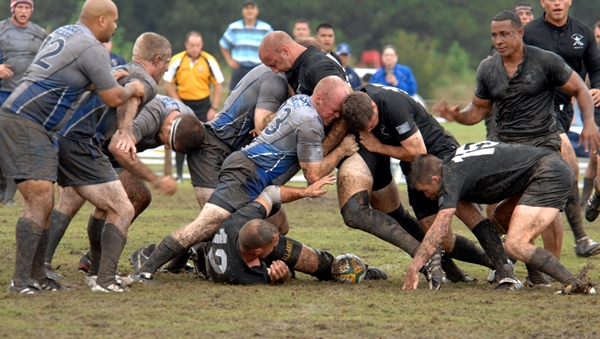9 March 2017. Two chemistry faculty in Michigan developed a simple sensor that measures the force and shows the location of head impacts in contact sports. Marcos Dantus and Gary Blanchard, professors in the chemistry department at Michigan State University, also started a company in Okemos, Michigan to develop the product they call Rosh Sensors, now in products offered for sale.
Dantus and Blanchard sought a simple and inexpensive way for parents, coaches, and trainers in sports like American football, rugby, and lacrosse to identify potentially dangerous blows to the heads of young athletes. Speed and simplicity were two key factors in designing their solution. These sports are played outdoors in all types of weather, where mud and sweat can make electronic sensors unusable.
“Other monitors are available,” says Blanchard in a university statement, “but they can be expensive and overly sensitive to weather and other extreme conditions experienced during competition. Many times these models have to be connected to a computer, have the data downloaded and then have it analyzed before any recommendations regarding concussion protocols can begin.”
The sensor is printed into a strip of treated paper that fits into a headband or cap worn by itself or under a helmet. If the impact on the athlete’s head has enough force, one or more stars appear on the strip. Since the strip wraps around the head, the position of the appearing stars can also indicate the location of the impact. Both of these indicators can alert a parent, coach, or trainer that the athlete should go through a formal concussion diagnostic protocol.
The inventors stress that the sensor does not diagnose a concussion. But the sensor can provide an early alert that a concussion may have occurred, to prevent further head impacts that can compound the initial damage. Preventing this so-called second impact syndrome, can also prevent serious injury, but most athletes don’t enjoy being sidelined and coaches want to be able to use all of their available players. “The key decision that our product can help address,” notes Dantus, “is ‘return to play.’”
Once they developed the basic sensor, Dantus and Blanchard went through dozens of headband prototypes before settling on a design similar to one worn today by athletes. The inventors made the strategic decision to outsource production of the sensors, headbands, and caps, which made it possible to concentrate on developing the product and getting it on the market, which they accomplished in 18 months.
Consumers can order the headband and cap from the Rosh Sensors web site for under $40.00, but the company is introducing the product deliberately through high school teams in Michigan. As scientists, the inventors are still collecting data on causes of head impacts (e.g., hard tackles or head hitting the turf), whether head impacts recorded by the sensor correlate to concussion diagnostics, and how sensor results influence decisions by parents, coaches, and team doctors. Results from these early adopters are expected to help further product design and development.
The company is also getting help from former Michigan State and NFL linebacker Brian McConnell, now chief operating officer of the company HPN Neurologic developing treatments for sports concussions. McConnell is recruiting other NFL alumni to encourage use of the sensors in California high schools.
“First concussions are a problem,” says McConnell, “but a second one soon after the first has the potential to do more damage. So, if you can tell someone to sit out after the first one and allow them to recover, then you’ll go a long way toward preserving their life, their health.”
More from Science & Enterprise:
- FDA Approves Trial Testing Stem Cells for Brain Injuries
- NeuroVive, Penn Partner on Traumatic Brain Injury
- Study to Develop Simple, Standard TBI Test Process
- Company Founded to Advance Concussion Treatment
- Phillips, Banyan Partner on Point-of-Care Concussion Test
* * *


 RSS - Posts
RSS - Posts
You must be logged in to post a comment.